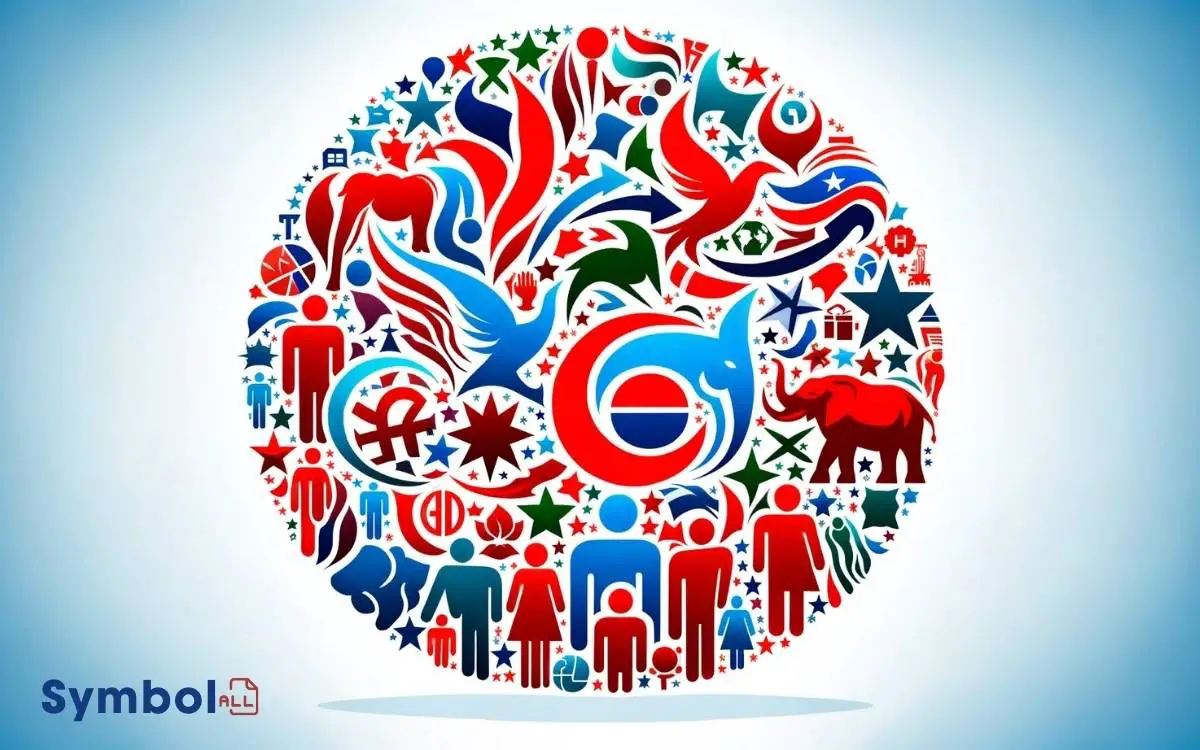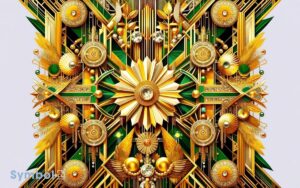Political Party Colors and Symbols: Explained!
In political landscapes, colors and symbols speak volumes. You’ll find red representing change and revolution, while blue stands for conservatism and trust.
These choices aren’t random; they’re steeped in psychological strategies to evoke specific feelings and associations among voters.
Symbols, from eagles symbolizing freedom to trees representing environmental commitment, are meticulously chosen for their cultural significance and ability to convey party values.
Understanding the historical context and psychology behind these choices deepens your grasp of political messaging.
As colors and symbols evolve, they continue to shape party identities and influence perceptions, offering a glimpse into the strategic minds of political campaigns.

Key Takeaway
The History of Political Colors
The adoption of specific colors by political parties has roots deeply embedded in history, reflecting ideologies, movements, and the evolution of political thought.
You’ll find that these colors aren’t chosen at random. Instead, they serve as a visual shorthand, conveying complex ideas and affiliations at a glance.
For instance, red has historically been associated with movements advocating for change or revolution, while blue often represents conservatism, stability, and trust.
This dichotomy isn’t universal, as the meaning behind these colors can vary greatly across different cultures and political landscapes.
Understanding this historical context enriches your grasp of the visual language of politics, allowing you to decode the intentions and philosophies that these colors symbolize in the political arena.
Decoding Symbols in Politics
Moving beyond the domain of colors, symbols in politics also play a pivotal role in conveying a party’s identity, values, and beliefs to the electorate.
These symbols, ranging from animals to objects, are meticulously chosen for their deep cultural and historical significance.
For instance, an eagle might represent strength and freedom, appealing to those who prioritize national security and liberty.
Similarly, a tree might symbolize growth and environmental commitment, resonating with voters concerned about climate change.
The Psychology Behind Color Choices
Understanding how political parties select their colors involves delving into the psychology that influences these choices, revealing much about their intended messages to voters.
Colors aren’t just aesthetic choices; they’re strategic tools that evoke specific feelings and associations.
For example, blue often symbolizes trust, stability, and calm, appealing to voters seeking security and reliability in governance.
On the other hand, green is frequently associated with environmental issues and growth, attracting those who prioritize sustainability and progress.
Red: A Global Political Staple
You’ll find that red’s historical significance in politics is deeply rooted, often symbolizing revolution, power, and passion across various cultures.
Its modern interpretations maintain these connotations, but also adapt to represent solidarity, courage, and social change.
Analyzing how political parties globally embrace red reveals its enduring appeal and versatile symbolism.
Reds Historical Significance
Delving into the color red’s historical significance reveals its deep-rooted association with power, revolution, and political movements across the globe.
Historically, red has symbolized the blood shed in struggles for liberation and the fiery spirit of those fighting for their rights. It’s been a banner for courage, attracting followers to its bold hue.
From the flags of ancient empires to the banners of modern revolutions, red has consistently represented a declaration of its universal appeal and the emotional response it evokes.
Understanding red’s historical context enriches your grasp of its enduring role in symbolizing political fervor and the unyielding quest for change.
Modern Interpretations of Red
Today’s global political landscape sees red’s enduring influence as a symbol of revolution, solidarity, and progressive ideologies, transcending its historical roots to remain a staple in contemporary movements.
This color’s versatility allows it to be adopted by various political entities, each infusing it with unique meanings while maintaining its core essence of change and passion.
| Emotion | Reason | Impact |
|---|---|---|
| Passion | Red’s association with heart and fire | Ignites activism |
| Unity | Common in flags and symbols | Fosters solidarity |
| Change | Historic revolutions | Inspires new movements |
Red’s visual impact is undeniable, often used to capture attention and evoke a sense of urgency. Its adoption across the spectrum underscores its universal appeal, making it a powerful tool in the arsenal of political symbolism.
Blue: Conservatism and Beyond
The color blue, often associated with conservatism, carries a broader symbolism in the political spectrum across various countries.
While you might immediately link blue with conservative values, its usage and implications go beyond a single political ideology.
Here’s how:
- Stability and Trust: In some nations, blue symbolizes stability and trust, appealing to voters who prioritize these values in their governance.
- Liberalism and Progress: Contrary to popular belief, blue also represents liberalism and progressive ideals in countries where traditional color associations are reversed.
- National Identity: In certain contexts, blue transcends political ideology, embodying national pride and unity.
Understanding blue’s multifaceted role in political symbolism reveals its capacity to unite and divide, reflecting the complex nature of political identity and allegiance.
Green: Environmental and Growth Ideals
Green, often linked with environmentalism, also embodies broader growth and renewal ideals within the global political landscape.
You’ll find that various political parties worldwide have adopted green to symbolize their commitment to these principles.
Here’s a closer look:
| Country | Party Name | Ideals |
|---|---|---|
| Germany | The Greens | Environmental protection, sustainable development |
| Brazil | Green Party | Environmentalism, social justice |
| India | Indian Green Party | Environmental preservation, grassroots democracy |
| Japan | Greens Japan | Non-violence, ecological wisdom |
This table illustrates how green transcends geographical boundaries, uniting various movements under the common goals of preserving nature and promoting sustainable growth.
Each party, despite differing national contexts, shares a commitment to environmental stewardship, showcasing green’s universal appeal as a symbol of ecological concern and a brighter future.
Yellow: The Color of Optimism
Yellow often symbolizes optimism, invigorating political landscapes with its bright and hopeful hue, suggesting a future filled with positivity and progress. When you see yellow in a political party’s colors, it’s not just a design choice.
It carries deep meanings:
- Hope and Happiness: Yellow evokes a sense of cheerfulness and enthusiasm. It’s a color that represents a positive outlook on the nation’s future.
- Innovation and Enlightenment: This color is also associated with creativity and intelligence, suggesting a party’s commitment to innovative solutions and enlightened policies.
- Visibility and Attention: Due to its high visibility, yellow grabs attention, symbolizing the party’s desire to highlight important issues and stand out in a crowded political field.
Understanding yellow’s implications helps you grasp the deeper intentions behind a party’s branding, revealing aspirations beyond mere political victories.
Purple: A Mix of Ideologies
Often symbolizing a blend of traditional and progressive ideologies, purple represents a political party’s commitment to unity and bipartisanship.
This color choice signifies an attempt to bridge the gap between differing political perspectives, aiming to appeal to a wider range of voters.
In the political spectrum, purple parties often find themselves mediating between the polarized ends, advocating for policies that incorporate elements from both sides.
They seek to find common ground, proposing solutions that respect the values and concerns of diverse groups.
The Role of Animals in Party Symbols
While exploring the visual identities of political parties, it’s notable that animals play a significant role in their symbols, embodying values, strengths, and characteristics they wish to project.
This strategic use of animal imagery isn’t arbitrary but deeply symbolic, offering insights into the party’s philosophy and appealing to a wide audience on an intuitive level.
Here are three ways animals are utilized in party symbols:
- Representation of Ideals: Lions for courage, eagles for freedom, and doves for peace.
- Cultural Significance: Certain animals hold specific meanings in various cultures, which parties tap into for broader appeal.
- Memorability: Animal symbols are easily recognizable, aiding in brand identity and recall during elections.
This approach underscores a deep understanding of visual communication’s power in political branding.
Flags and Political Identity
Flags serve as potent symbols of political identity, encapsulating a party’s values, history, and aspirations within their designs.
You’ll find that the colors, symbols, and patterns chosen for a flag are seldom arbitrary. Instead, they’re carefully crafted to communicate specific messages and unite supporters under a common visual banner.
| Country | Party Name | Flag Feature |
|---|---|---|
| USA | Democratic Party | Blue Color |
| UK | Labour Party | Red Rose |
| India | Bharatiya Janata Party | Lotus Flower |
This table highlights how different parties across the globe use unique elements in their flags to signify their political ideologies and goals.
Such symbols are not just decor; they’re a fundamental part of a party’s branding, helping to distinguish it in the crowded field of political discourse.
Stars, Stripes, and Political Messages
You’ll find that stars often carry deep symbolic meanings, reflecting ideals such as unity, ambition, and guidance in the context of political imagery.
Stripes, on the other hand, can serve as political signals, denoting concepts like solidarity and diversity, depending on their orientation and color.
Additionally, the choice of colors in these symbols communicates specific messages and values, making them a critical element in the visual identity of political parties. Additionally, the choice of colors in these symbols communicates specific messages and values, making them a critical element in the visual identity of political parties. Just as the red, white, and blue in the American flag evoke feelings of patriotism and unity, political organizations carefully select colors to align with their core principles and aspirations. For example, resources like United States symbols coloring pages can be a fun and educational way to explore how colors are used to represent national ideals and political affiliations, fostering greater awareness among younger audiences.
Stars Symbolic Meanings
Stars often symbolize unity, ambition, and guidance, playing a pivotal role in the visual rhetoric of political messages and party identities.
When you see a star on a political banner or emblem, it’s not just a decorative element; it carries deep symbolic meanings.
- Unity: Stars represent the coming together of individuals under a single cause or ideology, suggesting a collective strength.
- Ambition: They embody the aspirations and goals of a political movement, pointing towards a brighter future or higher ideals.
- Guidance: Like navigational stars that have guided explorers for centuries, stars in political symbolism suggest direction and leadership, offering a path forward.
Understanding these symbols allows you to grasp the underlying messages and values political parties aim to communicate, enriching your comprehension of political discourse.
Stripes as Political Signals
Much like their celestial counterparts, stripes serve as critical conveyors of meaning in political symbolism, embodying principles such as unity and diversity.
When you observe the use of stripes in political flags, insignias, or logos, you’re witnessing a deliberate choice to communicate specific ideals.
Stripes can represent the coming together of different states or entities, suggesting a unity that strengthens the whole.
Similarly, the number of stripes might symbolize historical events or foundational principles of a nation or group. Their orientation, whether horizontal or vertical, can also convey distinct messages.
Horizontal stripes often suggest solidarity and stability, while vertical stripes can imply strength and growth.
It’s this versatility and capacity to represent complex concepts through simplicity that make stripes a potent symbol in the realm of political communication.
Messages in Color Choices
Exploring the domain of political symbolism, the colors chosen by parties and movements speak volumes about their values and ideologies. You’ll find that each hue carries a distinct message, subtly influencing perceptions and alliances.
Here’s a breakdown of what these colors generally represent:
- Red often signifies strength, courage, and revolution. It’s a color that demands attention and is frequently adopted by parties seeking change.
- Blue is associated with stability, trust, and conservatism. Parties leaning towards these principles might favor blue to communicate their commitment to tradition and order.
- Green usually represents environmentalism and growth. It’s chosen by movements focused on sustainability and ecological concerns, signaling their dedication to preserving nature.
These choices aren’t arbitrary; they’re calculated decisions aimed at resonating with the public’s values and aspirations.
The Impact of Color in Campaigns
The use of color in political campaigns greatly influences voter perception and engagement, shaping the identity and message of a party.
When you choose a color, you’re not just picking a shade; you’re invoking a set of emotions and values that resonate with your target audience.
Red, for instance, often symbolizes strength and passion, potentially rallying supporters and conveying a sense of urgency.
Blue, on the other hand, might evoke feelings of stability and trust, appealing to voters seeking reliability in governance.
Each color carries its unique psychological impact, subtly guiding voters’ feelings towards a party or candidate.
In addition, consistency in color usage across campaign materials can enhance brand recognition, making it easier for voters to identify and remember your message.
Hence, understanding and strategically employing color can have a significant impact on a campaign’s success.
Controversial Symbols in Politics
You’ll find that symbols in politics often carry deep-seated meanings, which can lead to controversy when misinterpreted or viewed through the lens of historical context.
The impact of such misinterpretations can greatly alter public perception, influencing both support and opposition.
It’s important to understand the relevance of historical context to fully grasp the complexities these symbols embody in the political arena.
Symbol Misinterpretation Impact
Why do certain political symbols spark controversy, and how does their misinterpretation impact public perception and the political landscape?
When symbols are misunderstood, they can lead to significant consequences:
- Polarization: Misinterpretation can exacerbate divisions within society, as groups may rally around or against symbols based on incorrect assumptions.
- Miscommunication: Political parties and their supporters might find it difficult to convey their true ideologies and intentions, leading to public confusion and skepticism.
- Damage to Reputation: A party or movement’s image can suffer, sometimes irreparably, if symbols they use are associated with negative or controversial historical or cultural connotations not intended by the party.
Understanding the meaning and context behind political symbols is vital for accurate communication and fostering a more informed electorate.
Historical Context Relevance
Delving into the historical context of controversial symbols in politics reveals their profound impact on shaping public opinion and party identities.
These symbols, often rooted in complex histories, carry weighty meanings that influence perceptions and behaviors.
For instance, a symbol may be embraced by a political party due to its historical significance, yet it might also carry negative connotations for others, leading to polarized views.
Understanding the origins and evolutions of these symbols is vital, as it offers insights into their multifaceted roles in political discourse.
Evolution of Political Emblems
Over time, political emblems have undergone significant transformations, mirroring shifts in ideology, technology, and societal values.
The evolution can be broken down into three key phases:
- Traditional Symbols: Initially, emblems were simplistic, often using natural elements and animals to represent strength, wisdom, or freedom. These symbols were easily recognizable and could be replicated without modern technology.
- Adoption of Colors and Simple Graphics: As printing technology evolved, political parties started incorporating colors and simplified graphic designs. This shift allowed for quicker recognition and differentiation between parties.
- Digital Era and Branding: With the advent of digital technology, political emblems have become more sophisticated, incorporating complex designs and branding strategies. They’re now designed to resonate on multiple platforms, from traditional banners to social media, reflecting a more targeted approach to voter engagement.
Color and Symbolism in Modern Elections
In modern elections, the strategic use of colors and symbols plays a pivotal role in shaping public perception and party identity.
You’ll find that each color and symbol isn’t chosen at random but is deeply rooted in psychology and cultural contexts to evoke specific emotions and associations.
| Color | Emotion Evoked |
|---|---|
| Red | Passion, Energy |
| Blue | Stability, Trust |
| Green | Growth, Renewal |
| Yellow | Optimism, Hope |
This table exemplifies how parties leverage these elements to connect with you on an emotional level, aiming to influence your perception and, ultimately, your vote.
The choice of a symbol, whether it’s an animal, a plant, or an abstract design, further enriches this narrative, offering a visual shorthand for the party’s values and ambitions, making it easier for you to identify and align with them.
Conclusion
In analyzing the artistry and strategy behind political party colors and symbols, it’s clear that choices aren’t just aesthetic, but deeply deliberate.
From the passionate power of red to the calm conservatism of blue, colors communicate core values and catalyze connections.
Similarly, symbols serve as succinct signposts, steering sentiments and solidifying support. As politics evolve, so do these visual vocabularies, reflecting shifts in societal values and strategic stances.
Ultimately, color and symbolism remain pivotal in painting perceptions and influencing ideologies.






